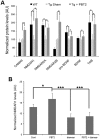Metal ionophore treatment restores dendritic spine density and synaptic protein levels in a mouse model of Alzheimer's disease
- PMID: 21412423
- PMCID: PMC3055881
- DOI: 10.1371/journal.pone.0017669
Metal ionophore treatment restores dendritic spine density and synaptic protein levels in a mouse model of Alzheimer's disease
Abstract
We have previously demonstrated that brief treatment of APP transgenic mice with metal ionophores (PBT2, Prana Biotechnology) rapidly and markedly improves learning and memory. To understand the potential mechanisms of action underlying this phenomenon we examined hippocampal dendritic spine density, and the levels of key proteins involved in learning and memory, in young (4 months) and old (14 months) female Tg2576 mice following brief (11 days) oral treatment with PBT2 (30 mg/kg/d). Transgenic mice exhibited deficits in spine density compared to littermate controls that were significantly rescued by PBT2 treatment in both the young (+17%, p<0.001) and old (+32%, p<0.001) animals. There was no effect of PBT2 on spine density in the control animals. In the transgenic animals, PBT2 treatment also resulted in significant increases in brain levels of CamKII (+57%, p = 0.005), spinophilin (+37%, p = 0.04), NMDAR1A (+126%, p = 0.02), NMDAR2A (+70%, p = 0.05), pro-BDNF (+19%, p = 0.02) and BDNF (+19%, p = 0.04). While PBT2-treatment did not significantly alter neurite-length in vivo, it did increase neurite outgrowth (+200%, p = 0.006) in cultured cells, and this was abolished by co-incubation with the transition metal chelator, diamsar. These data suggest that PBT2 may affect multiple aspects of snaptic health/efficacy. In Alzheimer's disease therefore, PBT2 may restore the uptake of physiological metal ions trapped within extracellular β-amyloid aggregates that then induce biochemical and anatomical changes to improve cognitive function.
Conflict of interest statement
Figures



References
-
- Tsai J, Grutzendler J, Duff K, Gan W-B. Fibrillar amyloid deposition leads to local synaptic abnormalities and breakage of neuronal branches. Nat Neurosci. 2004;7:1181–1183. - PubMed
Publication types
MeSH terms
Substances
LinkOut - more resources
Full Text Sources
Other Literature Sources
Medical
Molecular Biology Databases

